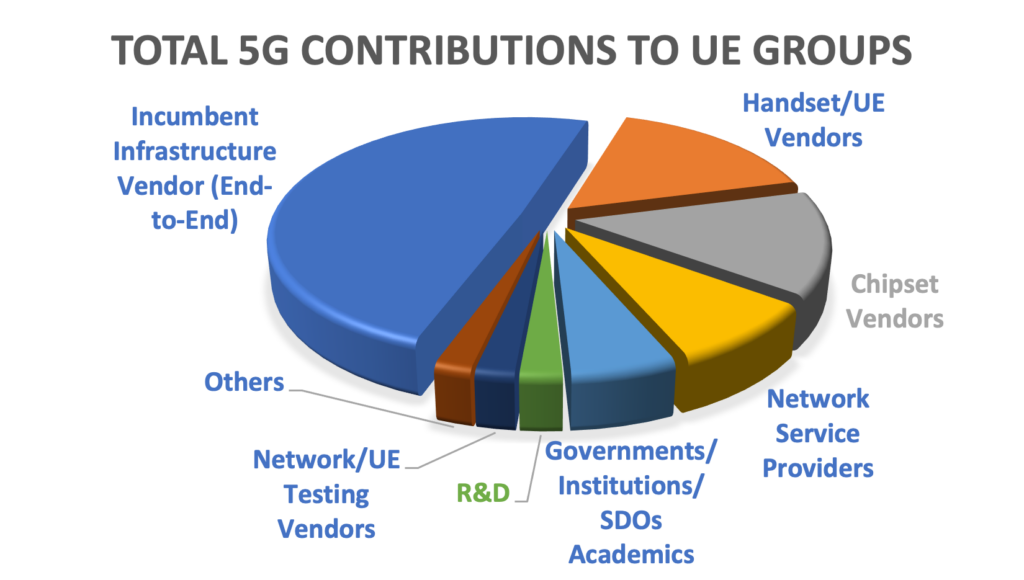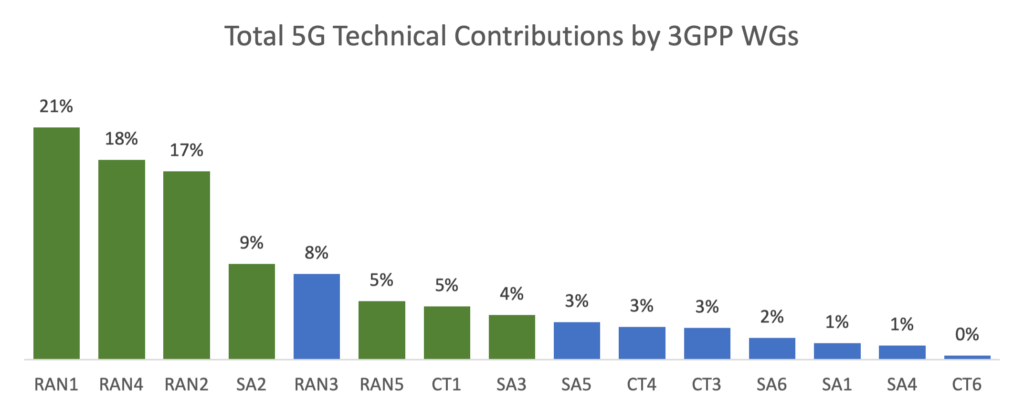There have been nearly 300,000 written contributions for 5G UE-related technologies.
Three big network vendors (Huawei, Ericsson, and Nokia) have been leading in both the number of contributions and approved contributions for 5G technologies to The 3rd Generation Partnership Project (3GPP). This is particularly the case with standards related to User Equipment (UE) specifications and functionalities that are developed under RAN1, RAN2, RAN4, RAN5, SA2, SA3, and CT1 Working Groups (WGs). The list of the top 20 most active companies within 5G 3GPP standards is listed in the table below:
| Top 20 Ranked by Total Contributions | Approved Contributions | Total Contributions | Company Category |
| Huawei | 15,266 | 43,753 | Incumbent Infrastructure Vendor (End-to-End) |
| Ericsson | 11,601 | 36,375 | Incumbent Infrastructure Vendor (End-to-End) |
| Nokia | 7,553 | 23,112 | Incumbent Infrastructure Vendor (End-to-End) |
| Qualcomm | 5,523 | 18,471 | Chipset |
| Samsung | 3,548 | 16,464 | Incumbent Infrastructure Vendor (End-to-End) |
| ZTE | 3,415 | 15,291 | Incumbent Infrastructure Vendor (End-to-End) |
| Intel | 2,151 | 10,770 | Chipset |
| LGE | 1,396 | 10,139 | Handset/UE Vendor |
| CATT | 1,934 | 9,792 | Government/Institution/SDO/Academics |
| vivo | 1,205 | 8,367 | Handset/UE Vendor |
| MediaTek | 1,848 | 7,766 | Chipset |
| OPPO | 818 | 6,728 | Handset/UE Vendor |
| NTT DOCOMO | 1,848 | 6,664 | Network Service Provider |
| CMCC | 1,823 | 6,362 | Network Service Provider |
| Apple | 955 | 5,183 | Handset/UE Vendor |
| Lenovo | 997 | 3,950 | Handset/UE Vendor |
| InterDigital | 456 | 3,756 | R&D |
| Xiaomi | 297 | 2,475 | Handset/UE Vendor |
| Rohde & Schwarz | 1,758 | 2,192 | Network/UE Testing Vendor |
| NEC | 461 | 2,135 | Incumbent Infrastructure Vendor (End-to-End) |
| Rest | 12,906 | 39,149 | Others |
| Grand Total | 77,759 | 278,894 | Others |
Standardization is critical in the mobile industry for promoting innovation, large-scale infrastructure deployment, compatibility, interoperability, and establishing systems that work globally. 3GPP is the industry association defining cellular standards. It operates on a consensus basis approach with thousands of companies contributing to Technical Specifications (TSs) for various standard releases and generations.
Contributions Related to User Equipment
ABI Research has selected contributions relevant to the terminal aspect of 5G because it is a vital innovation domain, with technical developments allowing these new types of services to materialize. There have been nearly 300,000 written contributions for 5G UE-related technologies received by 3GPP, representing about 80% of total contributions, showing strong interest from the supply chain to promote innovation with their Research and Development (R&D) outcomes.

Contributors include network infrastructure vendors (e.g., Huawei, Ericsson, Nokia, Samsung, ZTE, and NEC), chipset vendors (e.g., Qualcomm, Intel, and MediaTek), network service providers (e.g., CMCC, NTT DOCOMO, and AT&T), UE suppliers (e.g., vivo, OPPO, Apple, and Xiaomi), and government/institution/Standards Development Organization (SDO)/academic bodies (e.g., CATT, ETRI, Fraunhofer HHI, GSMA, and 5GAA), R&D companies (e.g., InterDigital), software/testing vendors (e.g., Rohde & Schwarz, Anritsu, and Keysight Technologies), and some vertical companies (e.g., Siemens and Mitsubishi). There have been more than 400 companies participating from the industry in 3GPP standardization; however, only a few companies are consistently active in driving 3GPP 5G standards. Network infrastructure vendors are significantly more active than any other company categories.

RAN1 (i.e., the physical layer of radio interface), RAN2 (i.e., the radio interface architecture and protocols), RAN4 (i.e., the Radio Frequency (RF) aspects in UE), and SA2 (i.e., the overall 3GPP system architecture) are the most important WGs impacting the entire mobile industry and receiving massive interest in terms of submitted contributions or offline discussions. This is very well expected as these WGs are the home of most of the normative and foundational TSs of 5G 3GPP standards. These normative TSs are often the target of the majority of Standards Essential Patents (SEPs) declared by various stakeholders.

Although counting contributions is not enough to recognize leaders in influencing 3GPP standardization processes, it is still a key element in identifying the active contributors to these standards, as a first step of identifying innovation. To disclose the further links from participation to material influence, we need to break down the details of contributions, their density, the strengths of the TSs targeted, and the full record of meetings, which would be challenging to complete for a whole database. In the future, ABI Research will investigate the relationship between 3GPP contributions and the database of SEPs, which may provide more indications for understanding technology innovations.
Key Takeaways
- Counting contributions alone is insufficient to identify leaders in 3GPP standardization processes. However, it is a crucial step in recognizing active contributors and identifying innovation.
- More than 400 companies from the industry have participated in 3GPP standardization; however, only a handful of companies are consistently active in driving 3GPP 5G standards.
- Huawei, Ericsson, and Nokia have, so far, been leading in both the number of total and approved contributions for 5G technologies to 3GPP.
- Network infrastructure vendors are significantly more active than any other company categories, followed by handset vendors, chipset vendors, network service providers, and government research institutions.
- UE-related WGs (i.e., RAN1, RAN2, RAN4, RAN5, SA2, SA3, and CT1) take 80% of total contributions. RAN1, RAN2, RAN4, and SA2 are the most important WGs, impacting the entire mobile industry and receiving massive interest.
Gu Zhang is a Principal Analyst in the 5G network infrastructure team, focusing on technology and strategic developments across the cellular infrastructure value chain. Her research includes a broad spectrum of topics, including development strategies of future RAN technologies, 5G-Advanced, 6G, 3GPP developments, cellular standards, patented and Open RAN.
